
Carolyn Kaster/AP
Federal Reserve Chair Janet Yellen speaks during a news conference following the Federal Open Market Committee meeting in Washington, Wednesday, Dec. 13, 2017
- Federal Reserve officials are increasingly concerned that low inflation may be more persistent than "transitory," and that could slow the pace of interest rate hikes.
- A flat yield curve, where long-term interest rates are unusually close to short-term rates, is a bad sign for the economy and is also a reason for Fed officials not to raise rates further.
- The Fed's forecasts still point to three interest-rate increases this year, but doubts from investors could lead to market turbulence later in the year.
Federal Reserve officials are becoming increasingly conflicted about whether to keep raising interest rates. That could spell trouble for a breathless stock market rally that many investors feel has already entered bubble territory.
At the center of the debate is a chronically-low inflation rate that signals the US economy and the job market are still operating below their full potential, despite the unemployment rate sitting at a 17-year low of 4.1%.
One of the Fed's preferred inflation measures stands at just 1.5%, well short of the central bank's 2% target, and there are fears that weak inflation expectations portend a further period of relative softness.
Minutes from the Fed's December meeting highlighted that tug-of-war, offering ammunition to both monetary policy hawks (who favor speedier rate hikes) and doves (who prefer to wait-and-see).
"With core inflation readings having moved down this year and remaining well below 2%, some participants observed that there was a possibility that inflation might stay below the objective for longer than they currently expected," the minutes said.
For now, the central bank's hesitance is not a major cause for concern as investors bid the US stock market to ever loftier highs. But if the rally begins to peter out later in the year as some expect, then a gap between market expectations of Fed action and the Fed's own forecasts could increase market volatility.
Low inflation may sound like a good thing, but when it's pervasive and persistent it can signal weak wage growth and a lack of demand for labor. Fed officials have long assumed a falling jobless rate would lead to stronger inflation pressures, but have consistently been disappointed.
"There is still confusion and disagreement about inflation," said Ward McCarthy, chief financial economist at Jefferies, in a research note.
"Policymakers also set the stage for different approach to addressing the inflation objective and how to decide if this objective has been met," he added. "The hawks continue to be rate normalization gradualists. The doves are perpetual pessimists who view rate normalization as an anathema, and will grab any available straw to slow the process."
That raises considerable uncertainty around the Fed's own projections for around three interest rate increases this year.
Bend it like the yield curve
A second key dilemma is also giving some policymakers pause about further interest rate rises: the unusually narrow gap between short-term borrowing costs and their long-term counterparts, known in market parlance as a flat yield curve. When long rates actually slip below short-term ones, the yield curve is described as "inverted," something that usually precedes a recession.
"This is a massive curve flattening and if the Fed continues to raise the policy rate" the curve may well invert, Daniel Alpert, founding managing partner of Westwood Capital, LLC, told Business Insider. "In the past that's always signaled a recession."
The Fed has raised interest rates five times since December 2015 to the current range of 1.25% to 1.5%. The gap between two-year Treasury notes and those on ten-year notes is currently around just a half percentage point, suggesting investors expect neither stronger growth nor accelerating investment returns in the foreseeable future.
The minutes said "several participants thought that it would be important to continue to monitor the slope of the yield curve."
In addition, "some expressed concern that a possible future inversion of the yield curve ... could portend an economic slowdown, noting that inversions have preceded recessions over the past several decades, or that a protracted yield curve inversion could adversely affect the financial condition of banks and other financial institutions and pose risks to financial stability."
Roberto Perli, a former Fed economist who is now co-founder and partner of Cornerstone Macro, wrote in a research note that "'several' is not a majority, but is also more than the few FOMC members we heard expressing concerns about a flat curve publicly in recent months.
"Since the curve is likely to continue to flatten, it could become one more issue that could prevent the FOMC from reaching the 2.75% terminal rate it currently projects," he said.
Both St. Louis Fed President James Bullard and Philadelphia Fed President Patrick Harker expressed concern about the flat curve and the prospect of an inversion in interviews late last year.
"We should just [maintain] a slow removal of accommodation to minimize the risk that [a curve inversion] would happen," Harker said. "I want to make sure we don't exacerbate that problem."